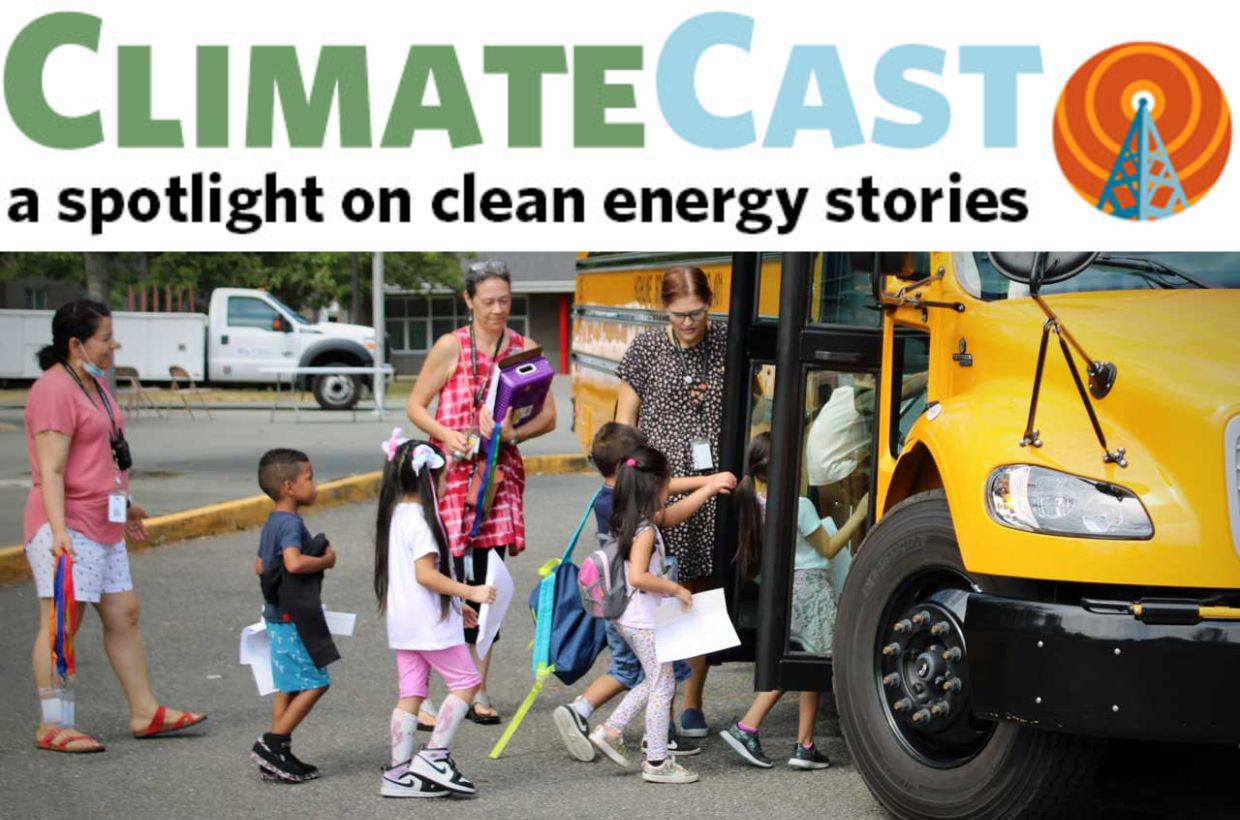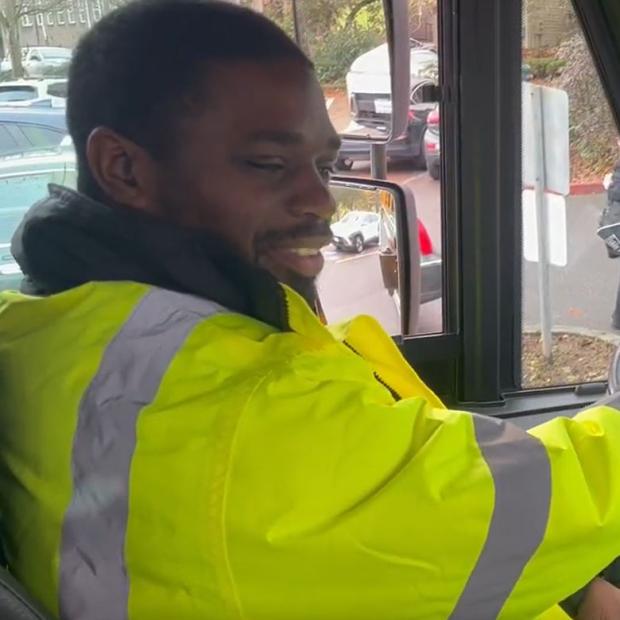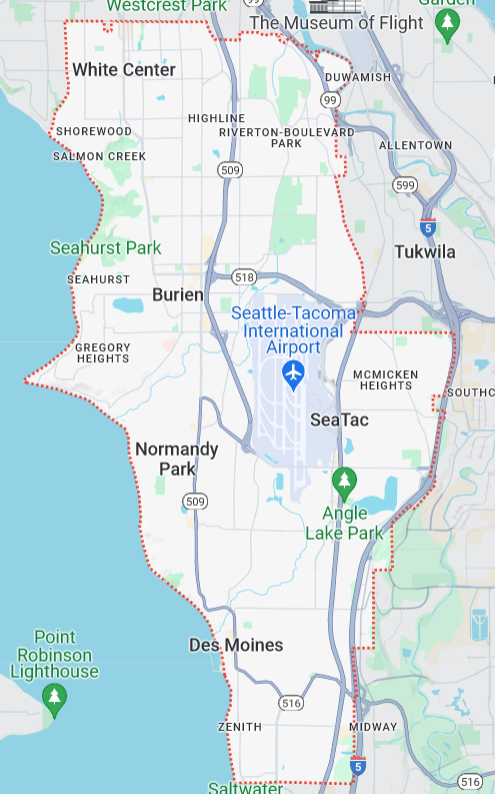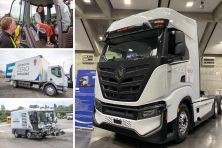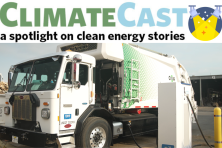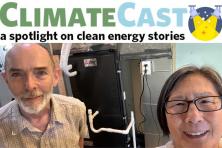Each month, ClimateCast features a Story Spotlight, covering climate issues and clean energy solutions that prioritize human experiences and connections in communities across the Pacific Northwest.
School buses are impossible to miss, even if you didn’t ride one to school as a child. Picture the typical school bus: the flashing lights, dozens of excited kids climbing aboard, the ever-present smell of those vinyl bench seats, stopping in the neighborhood and idling beside playgrounds before and after school. They’re also very noisy and, as it turns out, super polluting — very often equipped with a dirty diesel engine pumping smog out the rear tailpipe.
“I have driven buses from high school to preschool, I’ve driven buses that are diesel and now I drive the electric school bus and it’s phenomenal,” shared Theo White, a bus driver for the Highline School District.
And it’s not just about getting away from dirty diesel that Theo loves:
“The students get on and they love it. They look around and wonder why it’s so quiet. We have students that have autism and special needs. Driving this bus helps them a whole lot. The only thing you hear are the tires.”
Kids deserve to breathe clean, unpolluted air. Plenty of ink has already been spilled about the harms of polluted air in homes and classrooms. However, students are still routinely exposed to dirty, polluted air from a source in virtually every school district’s driveway: the school bus.
Across the nation, nearly 500,000 of these stout yellow vehicles ferry tens of millions of students — our next generation — between their homes, schools, extracurricular activities, and field trip sites every day. In fact, the public school bus system is the largest public transportation system in the country.
Newly-manufactured school buses are built to meet state and federal standards regarding crashworthiness, pedestrian visibility, and numerous other topics. However, there’s still an awareness gap among educators, school officials, and parents about the harms of exposure to school bus engine exhaust, despite having major health implications for the children riding them.
Approximately 95 percent of school buses operating in the United States run on diesel fuel. Diesel exhaust contains harmful particulate matter, toxic gasses like nitrogen oxide, and carbon dioxide, a climate pollutant. Students riding diesel-powered school buses — not to mention the communities served by these and other diesel vehicles — are routinely exposed to this dirty air, resulting in increased cases of childhood asthma and a variety of other health complications. Diesel-powered school buses also contribute significantly to climate pollution from the transportation sector (currently the largest source of greenhouse gas emissions in Washington state and the United States as a whole).
It’s important to point out that Highline is among Washington’s most racially diverse school districts, serving the cluster of communities between South Seattle and Federal Way. Numerous factories, warehouses, and transportation hubs, including the Seattle-Tacoma International Airport, are also in the area. This is hardly a coincidence; across the US, a myriad of environmental hazards, including major sources of air pollution, are clustered in and around low-income communities and communities of color — itself a legacy of racist public policies including redlining, urban renewal districts, and building highways through these communities. On top of that, it’s well established that asthma disproportionately affects low-income communities and communities of color. This makes adopting electric school buses in this area especially important: less diesel pollution means cleaner air, which translates to healthier children and families.
In addition to their sheer numbers and widespread use, school buses often remain in revenue service for 15+ years. As a result, fleet managers purchasing new diesel buses today are ‘locking in’ the pollution these buses create for decades to come. But there's a far better solution: replacing diesel-powered school buses with zero-emission electric school buses as they reach the end of their service life.
Electric school buses release zero tailpipe pollution (and don't even have a tailpipe), provide a much smoother and quieter ride to drivers and passengers, and offer major savings in fuel and maintenance costs compared to diesel-powered buses.
Several school districts in Washington state — Highline, Walla Walla, Loon Lake, Oak Harbor, and Tacoma — are already providing a cleaner ride to their students and communities by funding the adoption of electric school buses and working with local utilities to build out the necessary charging infrastructure. They're making it happen with state and federal clean energy incentive programs and public-private partnerships.
A (figurative and positive) sea change in government grant programs and other funding streams has arrived to help school districts and communities adopt electric school buses and other clean energy investments. The federal Infrastructure Investment and Jobs Act (IIJA) and Inflation Reduction Act (IRA) contain the biggest clean energy grant programs and incentives in US history. Vice President Kamala Harris visited the Pacific Northwest last year to announce the millions coming to each state, many Tribes, and all the U.S. territories over the next three years. Closer to home, Oregon and Washington have clean fuel standards on the books that create incentives for low-carbon fuels, including electricity generated from renewables. The Beaverton and Bend-La Pine school districts in Oregon now have electric school buses on the road thanks to that program. Better still, Washington state’s biggest polluters must clean up their pollution thanks to the Climate Commitment Act (CCA), which has already generated over $2 billion to reinvest in communities throughout the Evergreen State.
It’s great to see these school districts starting their clean energy transition and getting a bus or two, but far more school districts need funding for zero-emission buses and support to make this happen in support of all kids. Electric school buses are an outstanding clean energy solution for getting our kids from point A to B and beyond.
“They’re great. I’m happy to drive them, hoping we get more of these in the districts everywhere, because these things help, they’re here for everybody, all the kids,” Theo said before a crowd recently gathering to learn about Governor Inslee’s climate budget priorities for the 2024 legislative session. “I personally love driving them,” he concluded, before honking the electric bus horn to emphasize his excitement.
